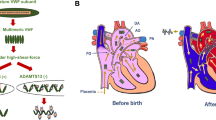Abstract
A case is presented of a neonate born at 32 weeks of gestation with intra-uterine growth retardation. The renal scan performed at 31 weeks showed oligohydramnios but normal kidneys. The neonate was oliguric from birth and required early peritoneal dialysis. Her urine showed heavy proteinuria, and the plasma albumin was very low. Post-natal ultrasonography showed large bright kidneys with reduced corticomedullary differentiation but no dysplastia; arterial and venous flow was normal on Doppler ultrasound. The quiz discusses the differential diagnosis with particular reference to whether this picture represents acute kidney injury with expected improvement or chronic kidney disease. Further questions discuss mechanisms of renal failure in this situation. Finally, with reference to previous case reports and series, a correlation between a specific mutation and this severe phenotype is proposed.
Similar content being viewed by others
Case summary
Sonia (not her real name) was a first child of consanguineous (first-cousin) parents of Pakistani origin. There was no family history of renal disease. Antenatal ultrasound at 20 weeks was normal, but at 31 weeks a repeat ultrasound showed oligohydramnios, and the fetus was small for dates, although the kidneys were reported to be normal. The pregnancy was otherwise uncomplicated, and the mother did not take any medications antenatally.
Sonia was born at 32 weeks weighing 1354 g (9–25th centile) by spontaneous vaginal delivery. No resuscitation was needed. On examination at birth, clitoromegaly was noted but was felt to be in keeping with the gestation of the infant. On day 1, oliguria (urine output 0.1 mL/kg/h) was noted and the plasma creatinine was elevated at 95 μmol/L. The oliguria persisted and the plasma creatinine increased to 248 μmol/L by day 4. The plasma albumin was very low at 7 g/L, but liver function tests were normal. Urinalysis on day 6 showed heavy proteinuria (4083 mg/mmol creatinine) and microscopic haematuria. Renal ultrasound showed slightly enlarged kidneys (both 4.2 cm in length) with a globular configuration, echogenic cortex and decreased corticomedullary differentiation. The kidneys were not dysplastic, nor did they demonstrate any evidence of reduced venous or arterial flow on Doppler. Manual peritoneal dialysis was commenced on day 7 and tolerated well initially.
Questions
-
1.
What are the features in the history, examination and investigations that suggest chronic kidney disease rather than acute kidney injury?
-
2.
What test or investigation will be most likely to lead to the underlying diagnosis?
-
3.
Suggest why oliguric renal failure occurred so rapidly
-
4.
What is the prognosis?
Author information
Authors and Affiliations
Corresponding author
Ethics declarations
Conflict of Interest
The authors declare that they have no conflict of interest.
Additional information
The answers to these questions can be found at http://dx.doi.org/10.1007/s00467-016-3332-6.
Rights and permissions
About this article
Cite this article
Carter, S., Dixit, A., Lunn, A. et al. Renal failure from birth—AKI or CKD? Questions. Pediatr Nephrol 31, 2257 (2016). https://doi.org/10.1007/s00467-016-3331-7
Received:
Revised:
Accepted:
Published:
Issue Date:
DOI: https://doi.org/10.1007/s00467-016-3331-7




